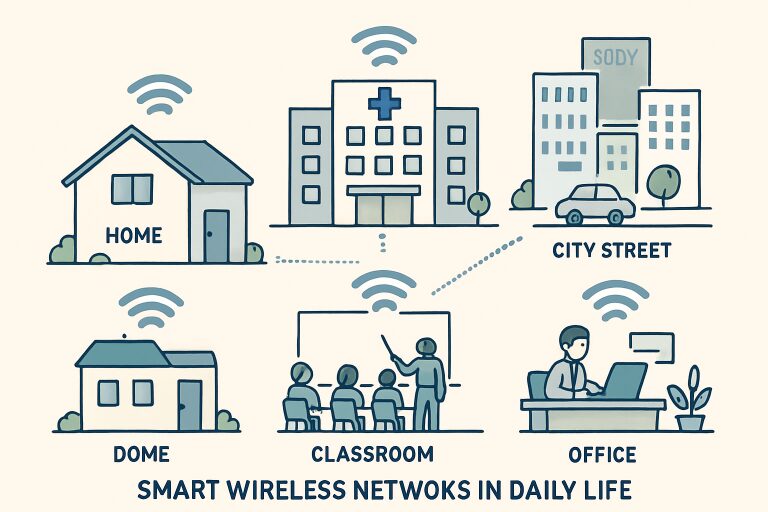From the home to the hospital, urban infrastructure to classrooms, intelligent wireless networks are now deeply woven into our daily routines. These networks form the technology that powers modern society’s seamless communication, smart automation, and transformative experiences. For businesses and organizations seeking advanced connectivity, professionally designed commercial wireless network solutions in San Francisco are critical to supporting evolving operational needs and delivering reliable digital innovation.
As wireless technologies become more sophisticated, they enable everything from real-time data exchange to smart city sensors, reshaping lifestyles and industries. By harnessing the power of advanced commercial wireless network solutions, organizations unlock unprecedented flexibility, security, and efficiency, fueling progress in urban living, sustainability, and economic growth.
Smart Homes: Enhancing Comfort and Efficiency
Modern wireless networks have redefined what it means to live comfortably and securely at home. Devices such as smart thermostats, intelligent lighting, and connected door cameras can all be managed from a mobile device or voice assistant, granting homeowners unprecedented convenience and oversight. Automated routines optimize energy usage, while security system alerts provide peace of mind even when residents travel, all powered by robust wireless connectivity. See The New York Times Wirecutter’s guide to smart homes for deeper insight into how these technologies reshape domestic life.
Healthcare: Remote Monitoring and Telemedicine
Healthcare is experiencing a significant transformation driven by wireless innovation. Wearable medical devices like smartwatches and continuous glucose monitors convey key health metrics to physicians in real-time, supporting the early intervention of chronic conditions and reducing unnecessary hospital visits. Telemedicine and virtual consultations have become widely accepted, particularly for patients in remote or underserved communities. Wireless connectivity ensures these vital healthcare services are robust, secure, and easily accessible, significantly improving patient outcomes and access to care.
Transportation: Smarter and Safer Journeys
Wireless network technology underpins the evolution of transportation. GPS guidance, vehicle-to-vehicle communication, and intelligent traffic management rely on ultra-reliable wireless infrastructures. Modern vehicles exchange data with urban infrastructure and other vehicles to improve navigation safety and minimize congestion. For instance, smart traffic signals adapt based on real-time flow, reducing wait times and maximizing commuter efficiency. As autonomous vehicles become more common, the importance of stable, high-speed wireless networks only grows.
Entertainment: Seamless Streaming and Gaming
Few sectors have been revolutionized by wireless technology as rapidly as entertainment. High-speed Wi-Fi and cellular networks enable instant streaming of movies, music, and games to various devices, avoiding physical media and buffering delays. Gaming platforms leverage low-latency connections for immersive online experiences, with cloud gaming services now accessible almost anywhere. Consumer demand for seamless content has driven rapid residential and commercial wireless infrastructure investment. Further insights into the impact of wireless networks on media and entertainment can be found in this CNBC feature on digital entertainment evolution.
Workplace Productivity: Flexible and Collaborative Environments
The modern workplace has evolved far beyond the traditional desk or fixed office environment. Thanks to secure wireless networks, employees can work seamlessly from virtually anywhere, collaborating across cities or continents. Multiple devices—from laptops to smartphones—connect workers in real-time, ensuring smooth communication and coordination. Cloud-based platforms have revolutionized productivity, enabling teams to share files instantly, host video conferences, and oversee complex projects without being limited by physical location. This flexibility fosters business agility, supports hybrid and remote work models, and allows companies to recruit top talent from around the globe. As a result, organizations can maintain high productivity, strong collaboration, and continuous connectivity, even in an increasingly decentralized professional landscape.
Education: Interactive and Accessible Learning
Wireless connectivity has transformed education into a more interactive, inclusive, and adaptable experience. With internet access, students can tap into digital textbooks, join virtual classrooms, and work together on projects regardless of location, enabling learning beyond the traditional classroom. Educators can integrate advanced educational technology tools—such as interactive simulations, online assessments, and personalized learning platforms—to tailor lessons to individual needs and learning styles. This level of flexibility has proven especially valuable during emergencies, such as pandemics, and in rural or underserved areas where access to resources is limited. By removing geographical and logistical barriers, wireless connectivity fosters equal learning opportunities, encourages global collaboration, and connects students and teachers in once unimaginable ways.
Retail and Commerce: Personalized Shopping Experiences
The retail industry has embraced wireless technology to revolutionize the shopping experience, blending convenience with personalization. Mobile point-of-sale systems enable staff to process transactions anywhere in the store, reducing wait times and enhancing customer service. Location-aware marketing and interactive displays engage shoppers with tailored promotions, product recommendations, and immersive content. Wireless beacons and sensors transmit real-time offers directly to smartphones, guide customers through store layouts, and provide valuable inventory tracking and management data. These tools improve operational efficiency and create memorable, customer-focused interactions. By integrating wireless innovations, retailers can drive higher sales, strengthen brand loyalty, and offer the seamless, personalized convenience modern consumers expect in physical and hybrid shopping environments.
Environmental Monitoring: Protecting Our Planet
The drive for sustainability increasingly depends on wireless sensor networks to monitor environmental indicators such as air quality, noise pollution, and water safety. Governments and organizations rely on these data streams to respond rapidly to environmental threats and inform long-term policies. Smart cities utilize connected devices to optimize energy, reduce waste, and manage resources responsibly, making urban living cleaner and more sustainable for future generations.
As wireless technologies advance and become even more embedded in daily life, their influence will expand, enabling smarter homes, healthier lives, safer journeys, and sustainable cities. Staying ahead requires access to reliable, high-performance connectivity solutions, ensuring individuals and organizations can fully benefit from the next wave of digital evolution.


